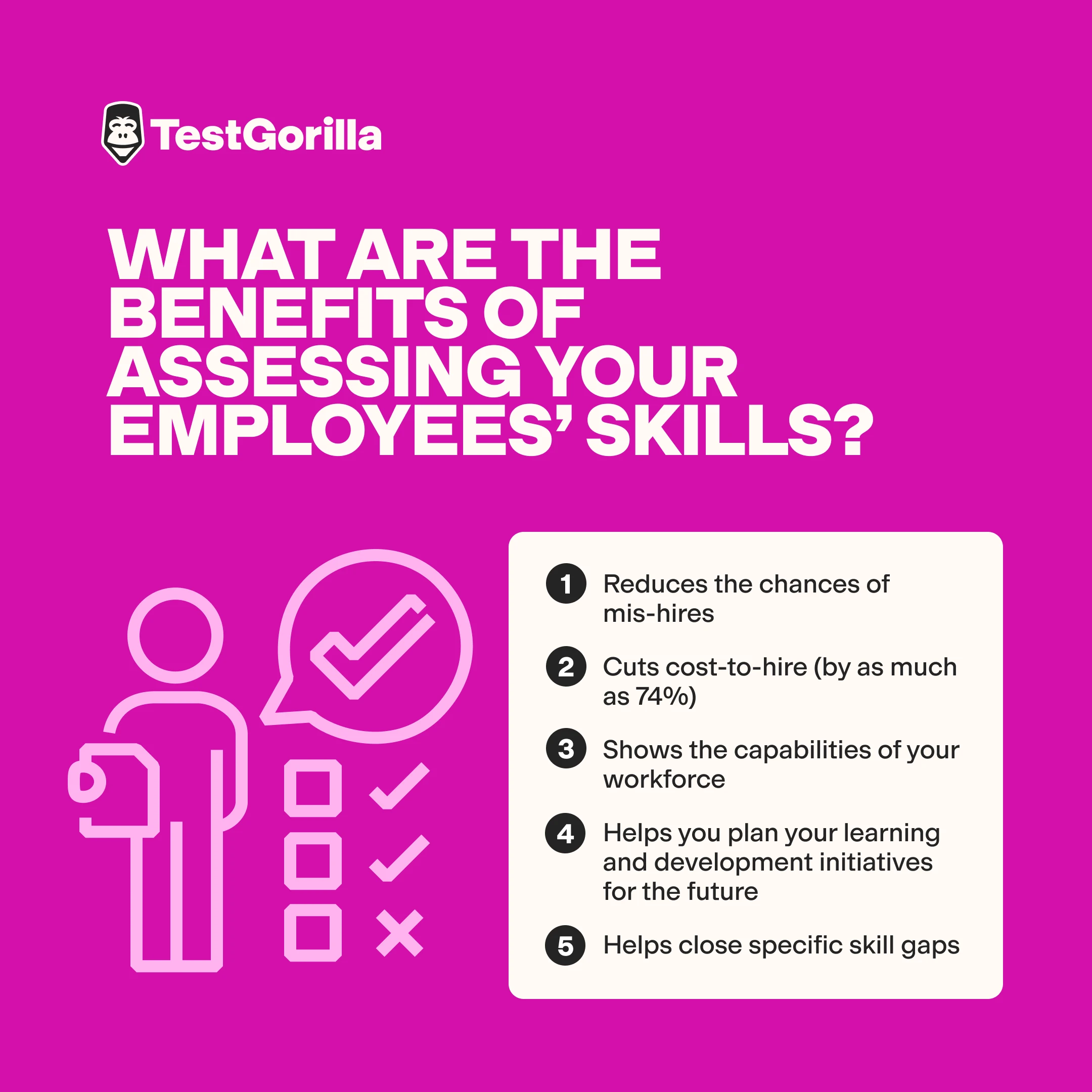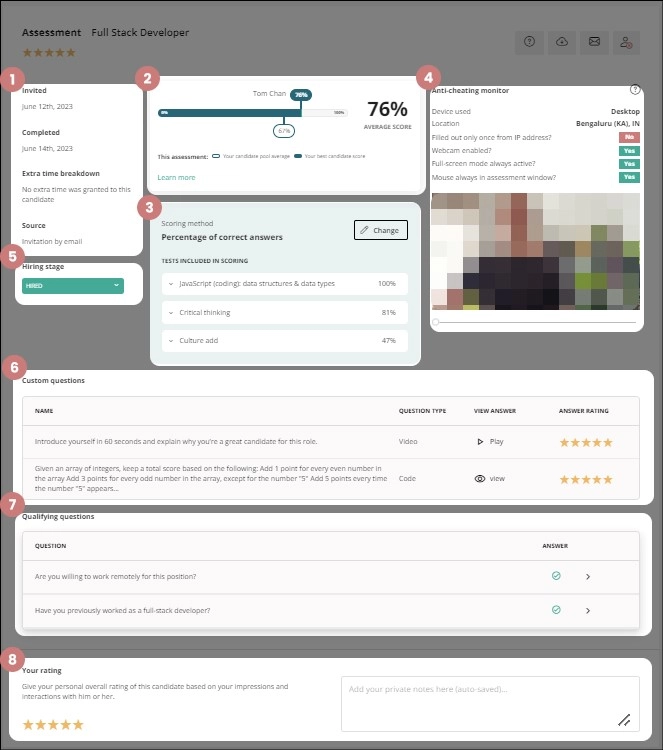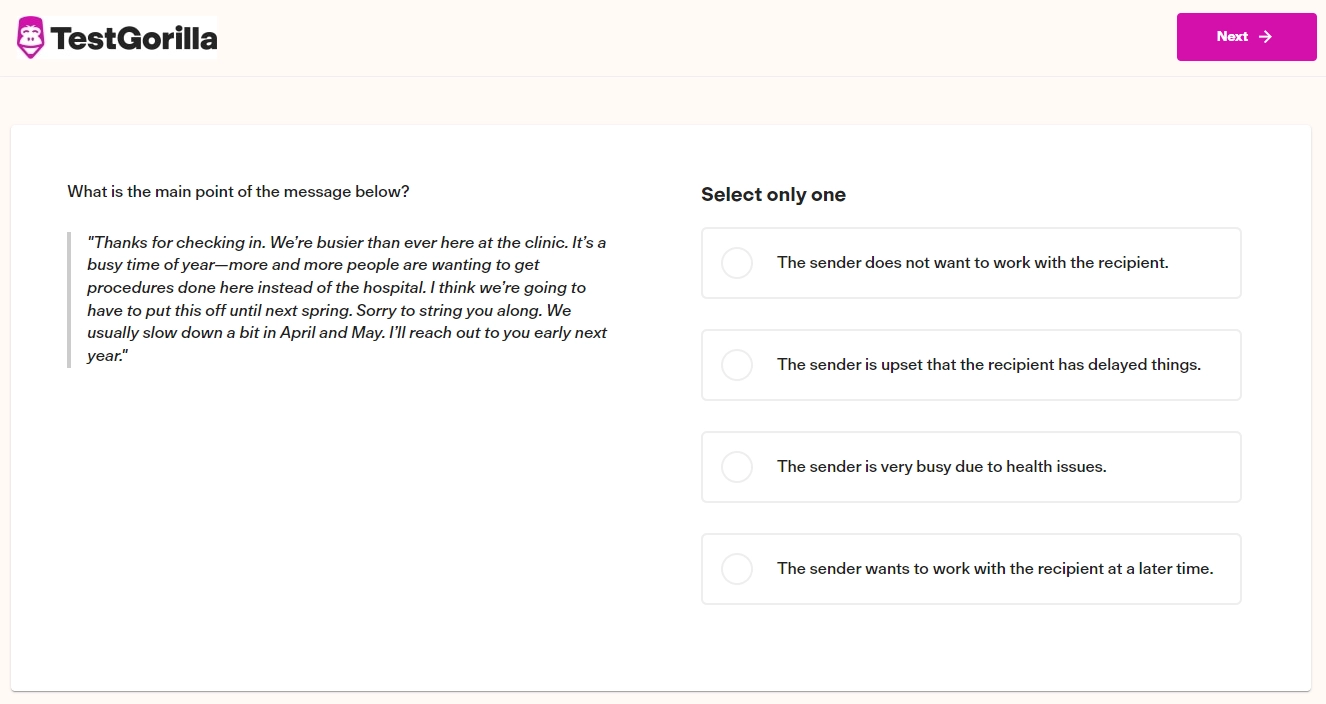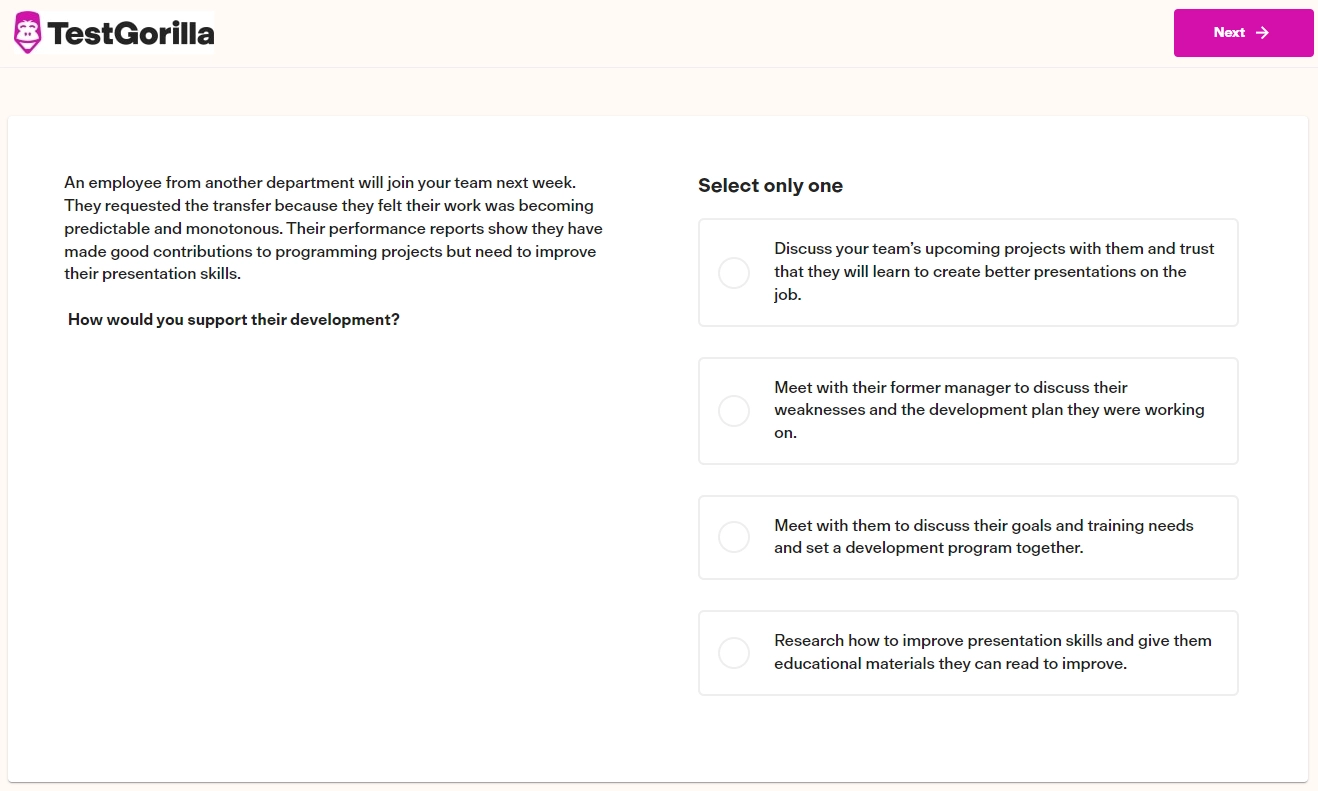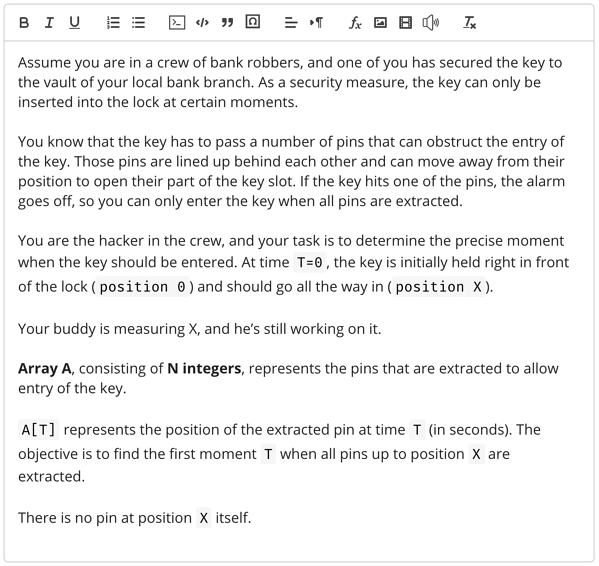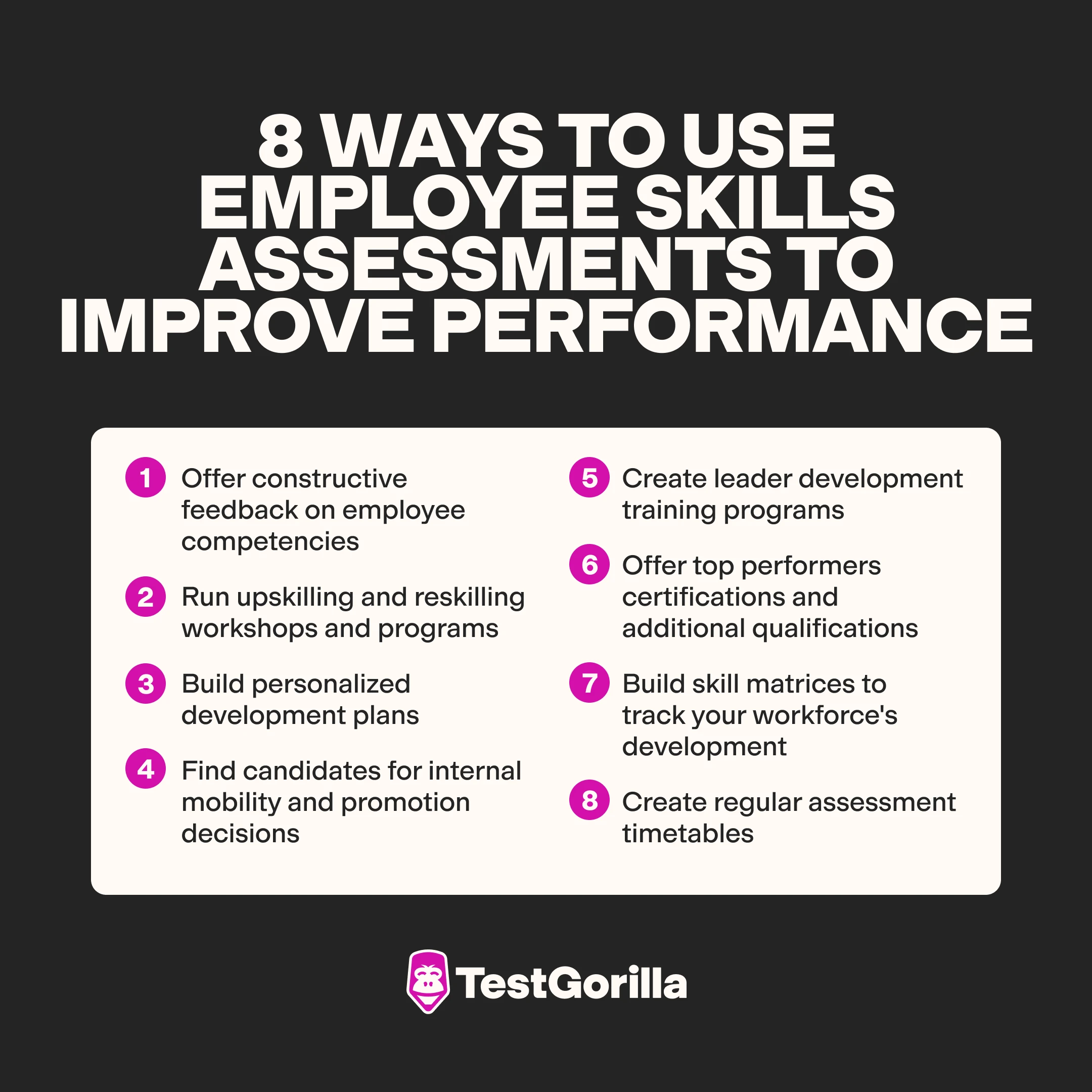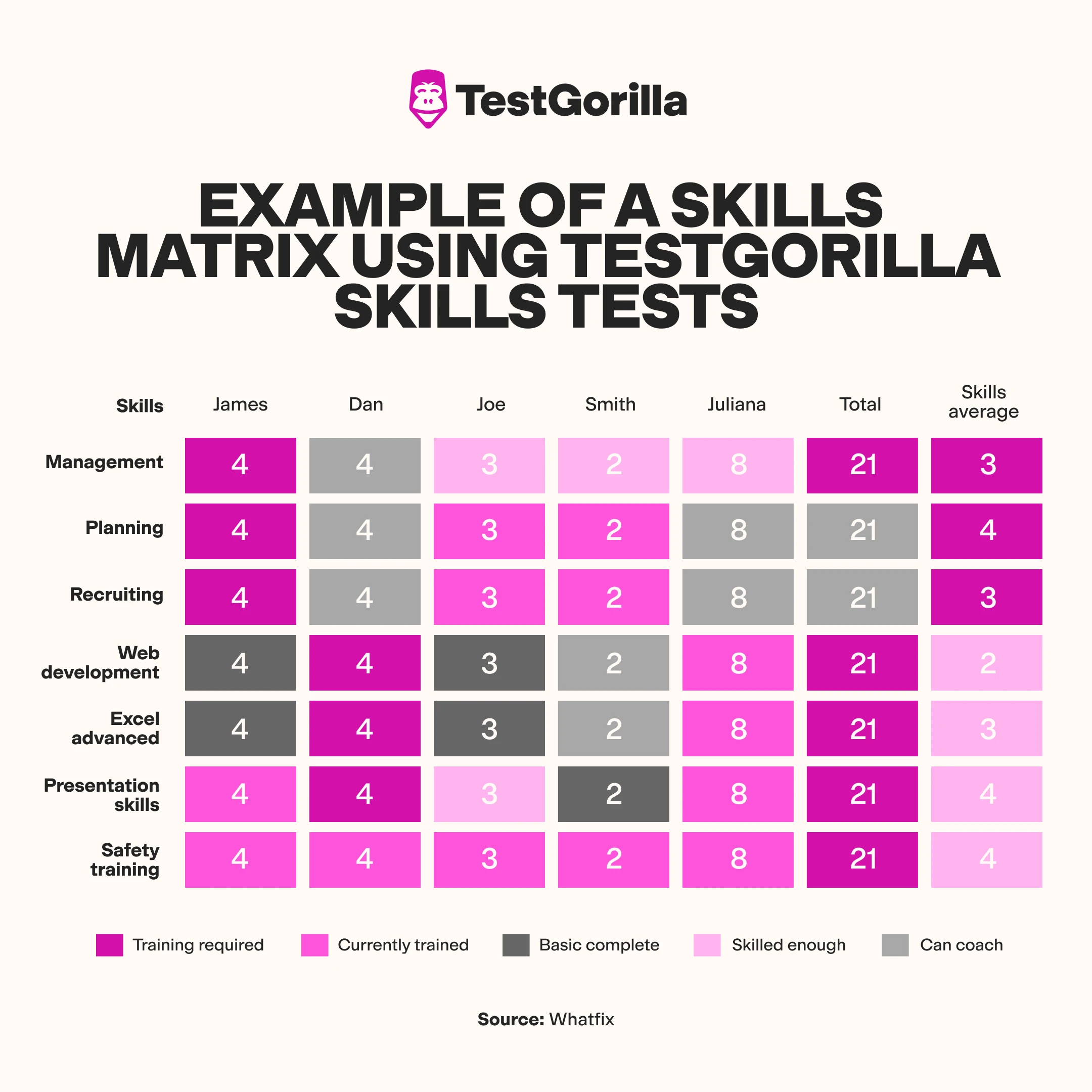Employee skills assessments: Maximize your team's potential by assessing skills and competencies
Find out what skills are available in your workforce.
Certain skills, like problem-solving, are important in any role – but how many of us can accurately gauge a team's strengths and weaknesses by looking at its performance?
An employee skills assessment is the answer. This assessment process helps you diagnose team skill deficiencies and identify areas for potential training, hiring, and onboarding.
In this article, we explain how to assess employees’ skills and abilities and give tips on how to use employee test results to improve your workforce.
Table of contents
- What is an employee skills assessment?
- What are the benefits of assessing your employees’ skills?
- How to assess employees’ skills and competencies: 5 methods
- When should you use an employee assessment?
- How to use employee skill assessment results to improve performance: 8 best ways
- Use employee skills assessments to help your talent grow
- Employee skills assessment FAQs
What is an employee skills assessment?
An employee skills assessment is a test or series of tests companies use to check employees’ capabilities in a particular role. Employee proficiency assessments are useful for internal recruitment and identifying specific organizational skills gaps.
Employee skill assessments reduce the chances of a mis-hire by testing all candidates with the same neutral measure. This approach eliminates bias and objectively identifies the most highly skilled candidates. Skills tests are useful for internal and external hiring because they prevent personal bias from swaying the results.
For example, without skills-based screening, a hiring manager may be more likely to choose an internal candidate they work with over an external candidate who’s more skilled.
According to a study, 48% of HR professionals admit to being biased in hiring decisions.
Skills testing also speeds up screening: Our client INMATEC significantly improved the efficiency of its hiring process by switching to using employment skills assessments.
Employee assessments can be done online or in person, for example, with a practical test. However, most employee skills assessment tools come as online tests because they are easier and quicker – not to mention cheaper – to set up and operate.
When setting up an employee skills assessment, you can group and administer various tests as a single skills testing package to your candidates. Doing so enables you to evaluate candidates on all the essential skills required for the position.
Then, all that’s left is to shortlist the highest-scoring candidates for interviews.
What are the benefits of assessing your employees’ skills?
Testing employees’ skills has several benefits, many of which go beyond understanding individual competencies and strengths.
Benefit | How testing employees’ skills helps |
Reduces the chances of mis-hires | - Validates candidates’ skills for the role - Objectively ranks candidates by skill level - Reduces bias, making hiring fairer and more accurate - Is proven to be a better predictor for job performance and retention than years of experience |
Cuts cost-to-hire (by as much as 74%) | - Reduces or eliminates time wasted sifting through resumes - Cutting down on mis-hires means you don’t waste money repeating the process |
Shows the capabilities of your workforce | - Lets you know what you can and cannot achieve with your current talent pool - Helps you make informed decisions on employee workload that are aligned with teams’ capacities |
Helps you plan your learning and development initiatives for the future | - Helps you spot weaknesses employees can improve with training - Shows you areas of potential for upskilling |
Helps close specific skill gaps | - Gives you the information to plan recruitment efforts for crucial competencies your workforce currently lacks - Helps you upskill your workforce by addressing specific skill gaps - Enables you to track the progress you’re making toward closing current skills gaps |
How to assess employees’ skills and competencies: 5 methods
Workplace skill assessments are effective because they enable you to test various aspects of an employee's competencies differently.
Here are five methods you could use to administer an employee competency assessment.
1. Employee skills tests
Employee skill tests are an effective means of collecting data on employees' competencies.
These tests give you an objective overview of each employee’s strengths and expertise and let you add notes to each profile:
Different skills assessment methods enable you to compare employees' abilities with set benchmarks, understand their personality traits, and identify areas for improvement.
Employee skills assessment types
The main types of employee skills assessments are:
1. Soft skills assessments
Soft skills assessments measure non-technical but crucial skills such as communication, time management, and teamwork. They are growing in importance as many technical skills are taken over by technology: One study predicted that soft skill-intensive roles are likely to account for two-thirds of all jobs by 2030.
Employee assessments use behavioral questions to measure soft skills.
For instance, a communication skills test might involve scenarios where candidates can convey information clearly and effectively verbally and in writing. Here’s an example from our Communication test:
2. Programming, software, and other technical skills assessments
These skills assessments evaluate specialized abilities and knowledge specific to roles or tools – for instance, programming languages like Python or Java.
3. Leadership skills assessments
These tests evaluate candidates for managerial or supervisory roles in decision-making, team motivation, and conflict resolution.
A leadership skill test for employment might simulate a challenging team dynamic or a critical decision-making scenario to gauge how a candidate performs in real-life leadership situations, for example:
4. Cognitive skills assessments
These tests measure a candidate's ability to think critically, solve problems, and process information efficiently.
5. Role-specific skills assessments
These assessments are tailored to specific job roles, evaluating the necessary skills and expertise. For example, a sales role assessment might focus on negotiation and customer relationship management skills.
6. Culture add assessment
This type of assessment determines how well a candidate could contribute to and align with a company's values and culture. Culture-add test questions reveal how a candidate handles ethical dilemmas or adds to the work environment.
Using a mixture of these employee tests ensures you get a holistic view of the skills and assets employees bring to your organization.
Get a holistic view of employees’ skills with diverse workplace skill assessments.
Explore TestGorilla’s test library and find out how our employee tests can supercharge your hiring.
2. Self-assessments
Ask your employees to run a self-assessment. With that, your employees:
Self-reflect on their skill sets
Define the areas in which they feel confident
Outline any areas in which they’d like to receive support
To get honest self-evaluations, explain to your staff that you use these assessment tests to identify opportunities to invest in employee development, not to punish them for self-identified weaknesses.
Based on the test results, set up mentorship programs for particularly knowledgeable employees to assist their colleagues in skill development.
3. Work performance appraisals
Another way to get a view of candidates’ skills is to look at their job performance.
For example, in an IT support role, you could look at the number of IT tickets they resolve and how their average resolution time compares with the wider team.
If they work with clients and customers directly, ask for feedback via a brief customer satisfaction survey.
This way, you gather data on your employees’ skills and customer satisfaction levels. You can then analyze this information to understand your employees' skills when interacting with customers and help them improve in specific areas.
4. 360-degree feedback from peers, managers, and customers
Combine feedback from peers and managers with employees’ self-assessments to get an even clearer picture of their competencies.
To get a full 360-degree assessment of a staff member, besides a self-evaluation, you need to ask for feedback from:
Peers
Managers
Subordinates
Look at 360-degree feedback to get an in-depth picture and serve as a data point when you assess the employee’s skills in the future.
Since feedback from coworkers always comes with a degree of subjectivity, consider general trends and compare opinions.
5. Business simulations
To assess your employees’ skills, put them in business simulations to understand how they would act in real-world situations.
Often, companies incorporate business simulations into online employee skills assessments.
A strong example is a coding test. Here, a business simulation is a question in an online skills test. Its purpose is to gauge the level of skills you’re looking for in a new developer:
Business simulations vary based on your industry and the specific roles you’re hiring for. However, they are useful when assessing whether your employees have the necessary competencies to deal with real-life situations.
When should you use an employee assessment?
Here are five examples of situations in which giving a skills assessment is useful:
When to use employee tests | Use an employee competency assessment to… |
Before awarding a promotion | - Check how qualified employees are for a promotion - See if employees can handle new responsibilities |
At the end of the working year | - Gauge the strength of your workforce - Plan your business goals for the next year |
During employee performance analyses | - Analyze employees’ performance by checking how advanced their skills are and how much they have improved |
During company performance reviews | - Check how well your employees understand and carry out their roles - Give specific, constructive feedback |
During recruitment | - Identify applicants who would excel in the open role - Eradicate hiring bias from your recruitment, improving diversity and the quality of new hires |
Maximize efficiency throughout the employee life cycle.
Start testing employees’ skills 100% free today to make data-driven hiring, promotion, and training decisions.
How to use employee skill assessment results to improve performance: 8 best ways
Once you start testing employees’ skills, you’re sitting on a goldmine of data for improving your business. But where do you start? Here are eight ways to use employee proficiency assessments to improve performance.
1. Offer constructive feedback on employee competencies
Constructive feedback entails understanding what went wrong and offering ideas for improving processes next time. Skills testing can help you with the diagnosis part of that equation.
If you start testing employees’ skills regularly, you give your managers useful data to consult during regular evaluations.
For example, skills test results might reveal that a sales associate with a poor sales record has great negotiation skills but is bad at lead generation. You can then give them lead generation training and observe the impact on their sales.
2. Run upskilling and reskilling workshops and programs
There are many ways to support employees once you’ve identified areas for improvement and additional training.
You can provide access to specific tools, such as online courses and libraries, for your employees to reskill. You can also provide business opportunities for them to develop their skills in real time.
Planning workshops to improve your employees’ competencies, whether internally or run by consultants or other companies, is another upskilling effective strategy.
Workshops are a particularly good option when you spot a weakness shared across a team – for example, poor communication skills. A workshop is a perfect forum for staff to start practicing this skill with each other until they excel at it.
3. Build personalized development plans
Testing your teams’ skills gives you insight into how to build better professional development plans.
A professional development plan is a document that establishes a worker’s career goals and provides details for how they can meet them. These plans contain:
Employee strengths
Areas of improvement
Resources they need
Strategies to implement
Using employee test results to hone their professional development could bring huge benefits. One study found that aligning HR processes with employee skill needs lowered training costs and boosted employee engagement by 50% and productivity by 40%.
4. Find candidates for internal mobility and promotion decisions
Storing employee skills assessment data in a database or internal talent marketplace enables you to search your current workforce for the skills you need for a new role.
Starting your internal candidate search with skills data reduces the bias that is often implicit in internal hiring and career development. For instance, managers often unconsciously choose the people they work with the most rather than those with the strongest abilities.
Facilitating internal mobility has other benefits. For example, employees promoted within three years of joining a company are 70% likely to stay on board, compared with just 45% of those who aren’t.
5. Create leader development training programs
Creating personalized development programs and identifying candidates for internal promotions gives you enough insight into your workforce to create targeted leadership programs.
Employee competency assessments are invaluable here. The assessment process shows you which employees are particularly competent in their area of expertise and which team members have budding leadership skills.
Skills tests like our Motivation test also help you by showing which employees have the strongest affinity with your organization’s values.
6. Offer top performers certifications and additional qualifications
Getting your employees certified helps improve their abilities at work and lowers the skills gap at your organization.
For example, you should consider sponsoring employees to complete certification programs in relevant software tools like HubSpot or Tableau. You should also allocate a certain number of working hours they can use to get certified.
This investment in their careers inspires loyalty in your employees and encourages them to stay long-term.
7. Build skill matrices to track your workforce's development
A skills matrix is a talent management tool that helps you visualize your workforce’s skills. You can use many methods to build a skills matrix, including:
Spreadsheets
Bar charts
Graphs
Tables
Infographics
Here’s an example of what it looks like:
Skills matrices are best separated by department to help compare skills across the organization. For example, you could create a skills matrix to show which departments are the most motivated or have the best problem-solving skills.
Departmental separation also makes it easier to spot candidates for promotion because it shows you which employees’ skills stand out compared with colleagues on the same career paths.
8. Create regular assessment timetables
Employee skills are evolving all the time: With each new project, your staff learns more about their areas of expertise. With this in mind, you must ensure you’re regularly retesting employees’ skills.
The schedule for this testing may differ between departments, with those in more rapidly-developing functions – such as tech workers – on a shorter cycle.
For your average employee, this could look like a yearly skills test examining metrics such as:
One or two core role-specific skills, such as Facebook Ads for a social media manager
Leadership and people management, to see if they are growing into a great manager
A skill that their manager has identified as an area of improvement, such as time management
A key soft skill, such as communication or problem-solving
Use employee skills assessments to help your talent grow
In this article, we’ve covered:
What an employee skills assessment is
The types of workplace skill assessment out there
How testing employees’ skills gives you valuable insights into your workforce
What to do with employee test data once you have it
To get this insight into your own workforce, get started with our Free forever plan today.
For an in-depth look at skills testing and how it could improve your organization, book a live demo with one of our team.
Or, to see our tests for yourself, take a product tour.
Employee skills assessment FAQs
Still unsure how employee skill assessment tools could help your business? Here are the answers to some common questions.
What are the examples of skills assessment?
Soft skills assessments, such as communication or time management
Hard skills, programming, and software skills assessments
Leadership skills assessments
Cognitive skills assessments, for example, verbal and numerical reasoning
Role-specific skills assessments
Culture add assessments, which evaluate employees’ alignment with the underlying values of an organization
How do you measure employee skill level?
Employee skills tests, such as cognitive skills assessments, evaluate things like numerical and verbal reasoning
Self-assessments, where employees reflect on their own performance
360-degree feedback from peers, managers, and customers
Business simulations, for example, a coding test where programmers must produce code to a brief provided by the employer
Which best practices should I use when running employee skills assessments?
A top best practice for running an employee skills assessment is asking all candidates to take the same test, which is especially important when trying out for the same job or performing the same function at work. This practice ensures a minimum opportunity for bias because you compare candidates’ results directly.
Related posts
You've scrolled this far
Why not try TestGorilla for free, and see what happens when you put skills first.
Latest posts
The best insights on HR and recruitment, delivered to your inbox.
Biweekly updates. No spam. Unsubscribe any time.

Skills tests to hire the best
Our screening tests identify the best candidates and make your hiring decisions faster, easier, and bias-free.
Free resources
A step-by-step blueprint that will help you maximize the benefits of skills-based hiring from faster time-to-hire to improved employee retention.
With our onboarding email templates, you'll reduce first-day jitters, boost confidence, and create a seamless experience for your new hires.
This handbook provides actionable insights, use cases, data, and tools to help you implement skills-based hiring for optimal success
A comprehensive guide packed with detailed strategies, timelines, and best practices — to help you build a seamless onboarding plan.
This in-depth guide includes tools, metrics, and a step-by-step plan for tracking and boosting your recruitment ROI.
Get all the essentials of HR in one place! This cheat sheet covers KPIs, roles, talent acquisition, compliance, performance management, and more to boost your HR expertise.
Onboarding employees can be a challenge. This checklist provides detailed best practices broken down by days, weeks, and months after joining.
Track all the critical calculations that contribute to your recruitment process and find out how to optimize them with this cheat sheet.

